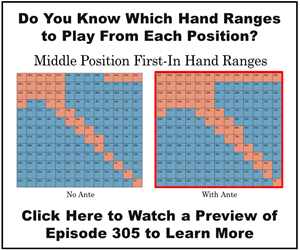Middle Set Facing a Flop Bet, what do you do here?
DECISION POINT: In a Tournament where blinds are 400/800 with a 800 big blind ante, you raise to 2,000 from Early Position with T♠T♦. Action folds to the Big Blind who reraises to 5,000 and you call. Villain bets 5,000 on the A♣T♥2♦ flop and action is on you, what do you do?
PRO ANSWER: We are playing in the mid to late stages of a multi table tournament. The blinds are 400/800 with an 800 big blind ante. We are dealt pocket tens first to act and make a standard opening raise to 2,000 chips. Oftentimes at this stage of the tournament a 2.5x or sometimes even 2.2x or 2x raise is more than enough to appropriately thin the field.
It folds around to the Big Blind who makes a 3-bet to 5,000 chips. We only have to call 3,000 more chips here, which is just a little more than 5% of the effective stack size with a lot of dead money already in the middle. Even if we somehow knew our opponent would only do this with bigger pairs we’re still getting the appropriate pot odds plus implied odds to continue here and attempt to flop a set.
Against a good, aggressive opponent we will also be facing some bigger Ax hands and even some bluffs or semi-bluffs with hands like A5s/A4s. Our opponent’s range isn’t nearly wide enough to consider 4-betting here, but this is a fairly trivial call once all factors are considered.
We do call and the flop is AcTh2d and we flop middle set. Our opponent bets 5,000 and action is on us. Many players are tempted to always raise here with middle set. However, if we examine the Big Blind’s range it’s mostly big pairs and Ax hands.
Continued below...
If we raise now we let many of the Ax hands off the hook by announcing our hand strength and potentially cause our opponent to fold when they are very likely to continue to commit chips on the turn and pot commit themselves if we just call . If they have exactly AA this is just a cooler and we likely lose our entire stack.
If the opponent has something more like QQ/KK then calling gives them a chance to either continue to bet future streets or potentially try and call when we bet a future street thinking we could be bluffing. Raising now would get them to easily (and correctly) fold.
There’s no real reason to protect our hand here as KQ/QJ/KJ are somewhat unlikely to be in our opponent’s range. Playing our hand slowly here has many advantages as opposed to raising.
Calling is the best play.
How would you play it?
Share your answer in the comments below!
Start Improving Your Game Today
Join LearnWPT ($5 Your First Month!) and Get:
Think Like a Pro
- The WPT GTO Trainer to play real solved hands and get instant feedback on YOUR leaks
- On-demand access to our full library of 450+ Strategy Episodes
- All of your poker questions answered with the Ask a Pro Feature
- Expert analysis from LearnWPT Pros using The Hand Input Tool
- Community Forums to discuss all things poker with fellow LearnWPT Members
- Downloadable Tools you can use at and away from the tables
To join (just $5 your 1st month) click the JOIN NOW button at the top of your screen or the button below and start improving your game!
Have Questions about LearnWPT? Email us at [email protected] and we’ll be happy to help!


